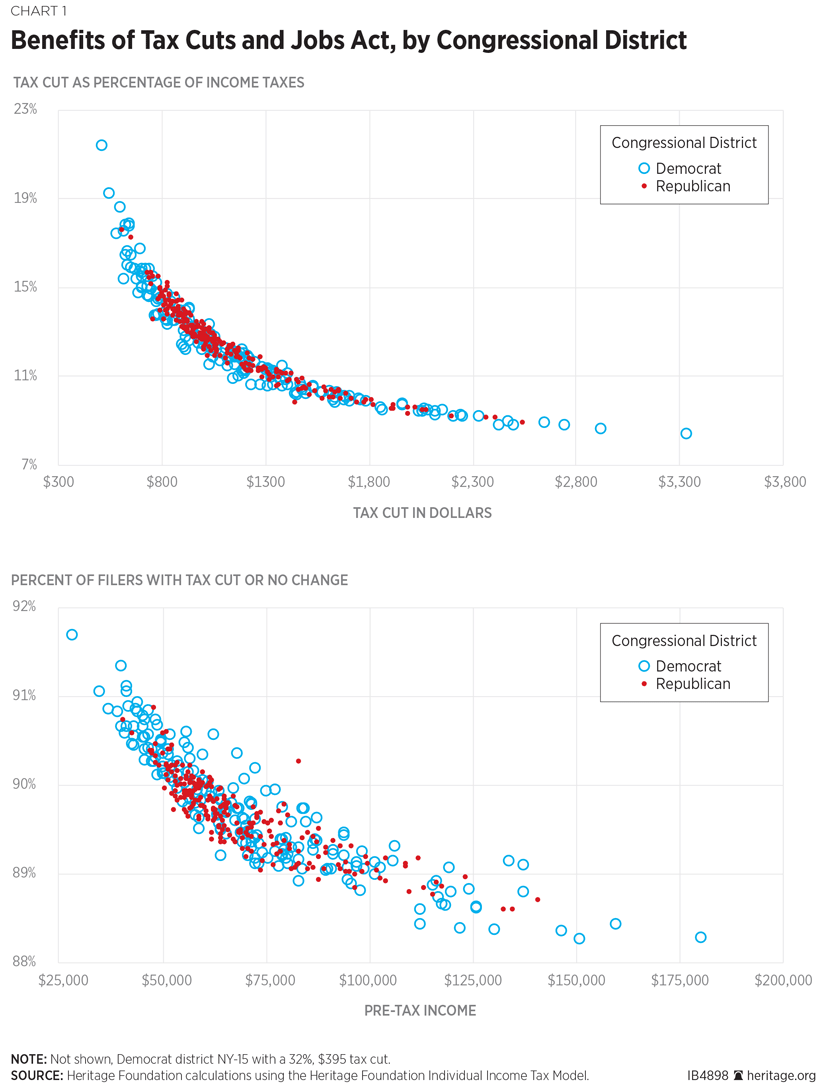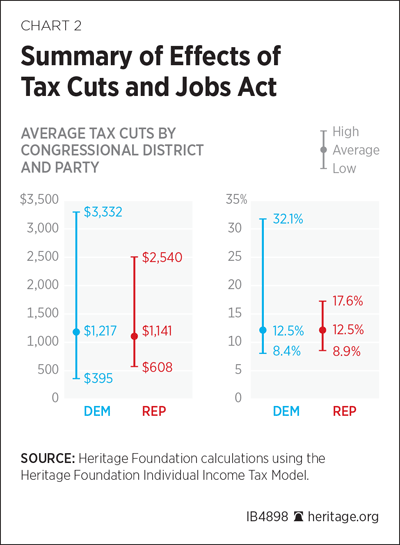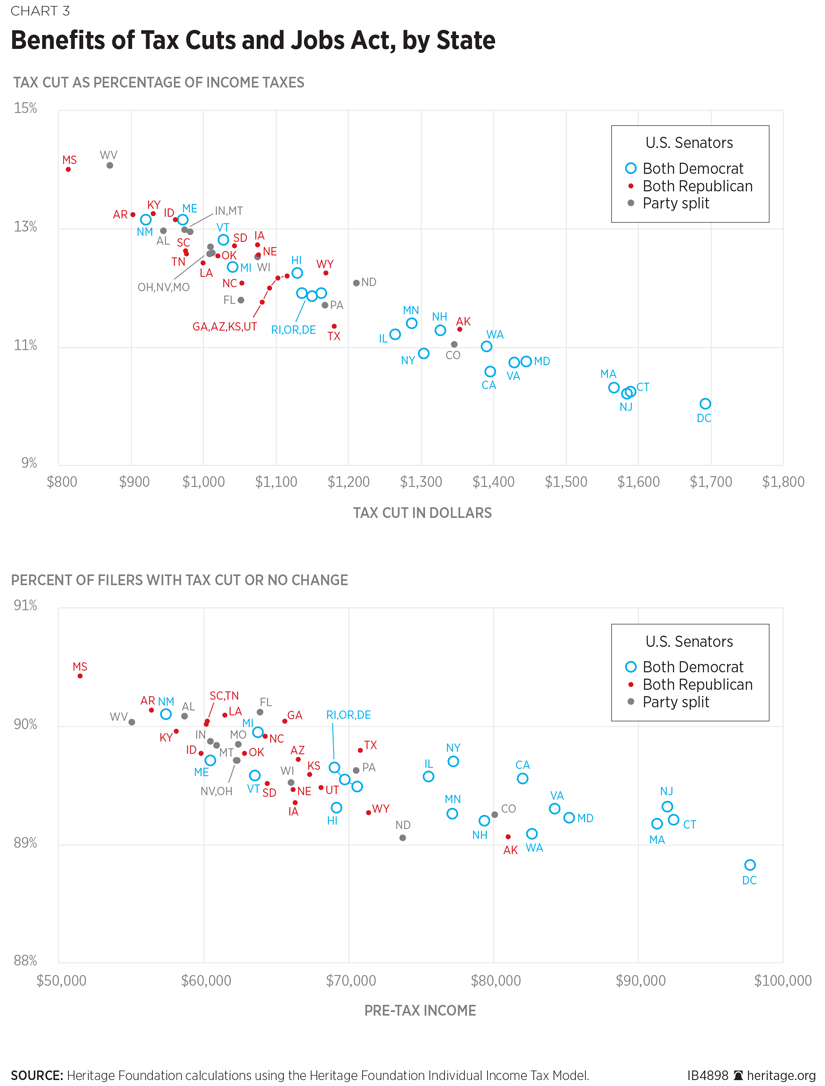A common argument alleges that the Tax Cuts and Jobs Act’s (TCJA) new $10,000 cap on the federal deductibility of state and local taxes (the SALT cap) is a politically motivated attack on Democrats and the states and districts they represent. Governor Andrew Cuomo (D–NY) called the cap “crass,” “ugly,” “divisive,” and “partisan legislating” in a recent State of the State speech.REF
The data tell a different story. Following the passage of the TCJA, average taxpayers in every congressional district and every state get a tax cut and more than 88 percent of individual taxpayers in every district and every state see a tax cut or no change in their 2018 tax liability.REF Among congressional districts, Democrats tend to represent areas with both the largest and smallest tax cuts. Republicans tend to represent the middle of the tax cut distribution.
The SALT cap is not partisan in nature. Instead, it moves towards a bipartisan goal of fairness by reducing an inequity in the federal tax code that allowed taxpayers with identical incomes to pay hundreds, thousands, and even hundreds of thousands of dollars more or less in federal taxes, strictly based on their state of residency. Moreover, the SALT cap—and more generally limiting the deduction to the greatest extent possible—is an important policy reform to better align state and local policymaker’s incentives with the economic effects of high taxes. The cap thus supports good state and local governance. The cap is only an intermediate reform; the deduction should be permanently eliminated in future legislation.
The State and Local Tax Deduction
Before the TCJA, taxpayers who itemized their taxes could deduct an unlimited amount of their taxes paid to state and local governments from their federal taxable income.REF The deduction reduces the income subject to tax rather than creating a one-for-one credit. Beginning in 2018, the new tax law limits the deduction to $10,000 of property taxes and income taxes (or sales taxes). Only about one in 10 taxpayers is expected to itemize deductions under the new tax code. For many taxpayers who will still deduct state and local taxes, the subsidy is largely unchanged. The changes primarily affect certain high-income taxpayers who live in high-tax areas.
The benefit of allowing taxpayers to write off the cost of state and local taxes accrues to the minority of taxpayers who itemize and implicitly raises taxes on everyone else. The write-off creates a federal subsidy for higher than average state and local taxes, which forces people in lower-tax states to subsidize more expensive governments elsewhere.
Before the TCJA, a taxpayer in New York making between $50,000 and $75,000 a year deducted on average $3,375 worth of state and local taxes from his federal taxable income. A taxpayer in Tennessee making the same income only deducted $924 on average, which increased his federal taxes by about $400 compared to his identical New York counterpart.REF These middle-class taxpayers will not be subject to the new SALT cap.
The disparity among high-income taxpayers was even larger: The average millionaire living in New York or California deducted more than $450,000 worth of state and local taxes; the average millionaire in Texas deducted only $50,000 and therefore paid close to $180,000 more per year in federal taxes.REF These high-income taxpayers will face the new SALT limitation.
Such disparate treatment is unfair, especially considering that the federal government provides the same services to taxpayers with similar incomes in New York, Tennessee, and Texas.
Various other changes in the TCJA compensate taxpayers for the effect of the new cap on the SALT deduction.REF Most taxpayers who are subject to the new SALT cap will see lower marginal tax rates, the option to take the larger standard deduction, and for those with pass-through businesses there is a new 20 percent deduction for qualified income. To assess the total impact of the SALT cap, the offsetting changes in the TCJA must also be included in the analysis.
Tax Cuts by Congressional District
Previously published Heritage Foundation data on the TCJA’s tax cuts in every congressional district shows four different ways to look at how the tax cuts benefit or harm American communities.REF All four measures indicate no apparent bias favoring either political party in the districts that benefited the most or the least.
The top panel in Chart 1 shows that the average filer in every congressional district gets a tax cut. Districts with a Democratic representative (blue) tend to have both the largest dollar value tax cuts and the largest percentage reductions in federal income taxes. These two measures are inversely correlated because the TCJA reduced taxes for people with the smallest tax burdens by the largest percentage, while high-income taxpayers with the largest tax burdens see the largest dollar value tax cuts.REF Chart 2 shows that individual districts with a Republican representative receive average tax cuts closer to their population average, with less variation than districts represented by Democrats.

The bottom panel in Chart 1 shows congressional districts by annual income and the percent of filers with a tax cut or no change in federal taxes paid after TCJA. Districts with Democratic representatives have both the highest and lowest percent of taxpayers who get a tax cut or face no tax change in 2018. The percentage with a tax cut or no change ranges from 91.7 percent to 88.3 percent and is highly correlated with pre-tax income.REF As can be seen in Chart 2, lower-income districts tend to have the largest percentage of filers who see a benefit and tend to be represented by a Democrat.

Tax Cuts by State
The data on tax cuts in each state show similar trends as those for the congressional districts. The top panel of Chart 3 shows that states with smaller average dollar-value tax cuts tend to receive the largest percentage reduction in their federal income taxes. States with one or two Republican Senators (red) tend to see the largest tax cuts in percentage terms and states with two Democratic Senators tend to see the largest tax cuts in dollars.
The bottom panel of Chart 3 shows that the range of the percentage of filers who receives a tax cut or no change across states is less than two percentage points (88.8 percent to 90.4 percent). Similar to the district analysis, the higher-income states tend to have a slightly higher percentage of taxpayers with tax increases. The bottom panel of Chart 3 also shows that the tax cuts correlate with income more than political affiliation. Lower-income taxpayers benefited the most from the doubled standard deduction. Higher-income taxpayers are more likely to be subject to the SALT cap and other changes that broadened the tax base.

The Direct Effect on State Governments
In addition to the impact that the TCJA will have on individuals, state policymakers, like Cuomo, are concerned that their budgets could face new constraints if their residents are not able to write off the full cost state and local taxes. Before the TCJA, residents still faced a higher state and local combined tax burden in higher-tax states; however, the additional cost was partially subsidized by other federal taxpayers. In the case of some high-income California taxpayers, their SALT deduction reduced their overall tax bill by 40 percent.REF
The SALT cap predominantly affects high-income taxpayers in high-tax states, and high-income taxpayers are more sensitive to higher marginal tax rates. If they are required to pay their full tax burden, they may choose to relocate to lower tax jurisdictions. If a millionaire taxpayer in New York can now only deduct $10,000 of her $450,000 state and local tax bill, the after-tax cost of living in New York over Texas could have gone up by more than $12,000 a year.
For most states, the federal tax changes created an unexpected revenue windfall that can be used to lower state tax rates to mitigate any budgetary concerns of high-income taxpayers moving elsewhere.
The federal tax reform broadened the tax base by eliminating the personal and dependent exemptions and limiting other deductions, leaving more income subject to tax. The reforms are paired with offsetting reductions in tax rates and a larger child tax credit so that most Americans get a federal tax cut. A majority of states use the same income tax base as the federal government, but set their own rates.REF Without offsetting rate cuts in the states, most states will see increased revenue in 2018.REF
Many states have already taken the opportunity to enact parallel tax cuts. Legislators concerned that the SALT cap will affect their constituents can follow the example of Georgia, Idaho, Iowa, Missouri, and Utah, and lower state tax rates in response to a broader tax base.REF The TCJA’s SALT cap is good federal policy because it moves the tax code towards equal treatment of all taxpayers of similar income, regardless of the state they live in. The cap also promotes good state tax policy because local legislators must now weigh the full economic cost of their tax burden since high taxes have a diminished federal subsidy.
The Next Step for the SALT Cap
Policymakers in both parties are campaigning to repeal the SALT cap or institute complicated workarounds in state tax codes. This is the wrong policy response. The existing SALT cap is not a partisan attack, but rather an opportunity for state governments to reform their tax codes. The current cap does, however, leave intact a large piece of the subsidy for high-tax states. Congress should capitalize on the successes of the TCJA and fully eliminate all state and local tax deductions for individuals and corporations as the next logical step for tax reform. The full and permanent elimination of the SALT deduction could allow federal tax rates to decline even further and meet the bipartisan goal of increasing the fairness of the federal tax code.
—Adam N. Michel is a Policy Analyst in Tax and Budget Policy in the Thomas A. Roe Institute for Economic Policy Studies, of the Institute for Economic Freedom, at The Heritage Foundation.


